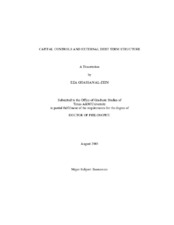| dc.description.abstract | In my dissertation, I explore the relationship between capital controls and the choice
of the maturity structure of external debt in a general equilibrium setup, incorporating
explicitly the role of international lenders. I look at specific types of capital controls
which take the form of date-specific and maturity-specific reserve requirements on
external borrowing. I consider two questions: How is the maturity structure of external
debt determined in a world general equilibrium? What are the effects of date- and
maturity-specific reserve requirements on the maturity structure of external debt? Can
they prevent a bank run?
I develop a simple Diamond-Dybvig-type model with three dates. In the low income
countries, banks arise endogenously. There are two short-term bonds and one long-term
bond offered by the domestic banks to international lenders. First I look at a simple
model were international lending is modeled exogenously. I consider explicitly the
maturity composition of capital inflows to a domestic economy. I show that the holdings
of both short-term bonds are not differentiated according to date.
Second, I consider international lending behavior explicitly. The world consists of
two large open economies: one with high income and one with low income. The high income countries lend to low income countries. There exist multiple equilibria and some
are characterized by relative price indeterminacy.
Third, I discuss date-specific and maturity- specific reserve requirements. In my
setup reserve requirements play the role of a tax and the role of providing liquidity for
each bond at different dates. I show that they reduce the scope of indeterminacy. In some
equilibria, I identify a case in which the reserve requirement rate on the long-term debt
must be higher than that on the short-term debt for a tilt towards a longer maturity
structure.
Fourth, I introduce the possibility of an unexpected bank run. I show that some
specific combination of date-and maturity-specific reserve requirements reduce the
vulnerability to bank runs. With regard to the post-bank-run role of international lenders,
I show that international lenders may still want to provide new short-term lending to the
bank after the occurrence of a bank run. | en |


